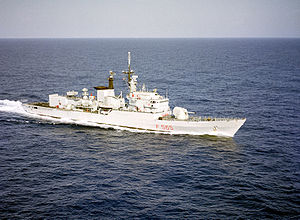Lupo-class frigate
 MM Sagitario (F-565) | |
| Lupo class | |
|---|---|
| General Characteristics (Italian version) | |
| Displacement: | 2,525 tonnes full load |
| Length: | 113.2 m |
| Beam: | 11.3 m |
| Draft: | 3.7 m |
| Propulsion: | CODOG 2 General Electric / Fiat LM2500 gas turbines: 50,000 hp 2 GMT A230-20 diesel engines: 7,800 hp |
| Speed: | 35 knots (55 km/h) |
| Range: | 4,350 nm at 16 knots (8,050 km at 30 km/h) |
| Complement: | 194 |
| Radar: | • SPS-774 (RAN-10S) early warning • SPQ-2F surface search • SPS-702 CORA surface search • Mk 95 fire control • SPG-70 (RTN-10X) fire control • 2 SPG-74 (RTN-20X) fire control • SPN-748 navigation |
| Sonar: | DE 1160B hull |
| Electronic Warfare: | • SLR-4 intercept • 2 SLQ-D jammers • 2 SCLAR decoy launchers • SLQ-25 Nixie torpedo decoy |
| Armament: | • 8 Otomat Mk 2 SSMs • 8 Sea Sparrow SAMs • 1 OTO Melara 127/54 mm gun • 2 Breda-Bofors twin 40/70 mm guns • 2 Mark 32 triple torpedo tubes |
| Aircraft: | 1 AB-212ASW helicopter |
The Lupo class is a class of frigates built by Cantieri Navali Riuniti (CNR) for the Italian Navy. Designed as multipurpose warships with emphasis on anti-surface warfare (ASuW), they have enjoyed some success in the export market, being acquired by the navies of Peru and Venezuela. A small run of a slightly updated version is known as the Soldati or Artigliere class.
Design
In the early 1970s, the Marina Militare faced an increased Soviet naval presence in the Mediterranean Sea which constituted a threat to its sea lines of communication as well as to its extensive coastline. To parry this menace, Italy started a naval expansion program which included frigates focused on ASuW (Lupo class) and on ASW (Maestrale class).
For the first part of the requirement, CNR presented a design for a 2,500-ton frigate with a high speed and a heavy weapons load. The ship employed a CODOG propulsion plant to achieve 35 knots, making it one of the fastest warships at the time. Armament included 8 SSMs, 8 SAMs, several gun systems, 2 triple torpedo tubes and an ASW helicopter, which was equivalent to that carried by larger warships. To save weight, Lupo-class frigates are highly automated, allowing a crew of around 200, lower than the 250 of the comparable Leander-class frigate.
Italian Navy
The Marina Militare commissioned four Lupo-class frigates between 1977 and 1980. These ships were deployed to the Persian Gulf first as escorts for tankers during the last stages of the Iran-Iraq War (1987–1988) and then as part of the Coalition forces during the Gulf War (1990–1991). After this operations the whole class underwent modernization which included fitting an SPS-702 CORA surface search radar and SATCOM equipment. After two decades in service, the four italian Lupo-class frigates were decommissioned in the early 2000s.
Peruvian Navy

Peru became involved early in the Lupo class frigate program, ordering four ships in 1973. The Peruvian ships were built to a modified design which included different radars, Aspide instead of Sea Sparrow SAMs and a fixed instead of a telescopic hangar. The first two were built by CNR at its shipyard in Riva Trigoso, Genoa, and commissioned in 1979. Construction work for the second pair was carried out under license by SIMA (Servicio Industrial de la Marina, Navy Industrial Service) at Callao, with the ships commissioning in 1984 and 1987. Of this, BAP Carvajal (FM-51) and BAP Mariátegui (FM-54) had their flight decks extended to allow ASH-3D Sea King helicopters to land and refuel, even though they can't be housed in the ship's hangar. As the ships have been regarded successful in service, the Peruvian Navy acquired the four Italian Lupos after their decommissioning, two were incorporated in 2005 and two in 2006.
Venezuelan Navy

Venezuela ordered six Lupo-class frigates from CNR in 1975 as a replacement for older warships. This units were commissioned between 1980 and 1982. In general terms, their appearance and equipment is similar to those built for Peru, except for some small differences in electronics. The first two ships, ARV Mariscal Sucre (F-21) and ARV Almirante Brión (F-22) were upgraded by Ingalls Shipbuilding over a four years period (1998–2002). Modifications have included new diesel engines, new radars, a new sonar as well as several new electronic systems. The other ships in Venezuelan service are expected to undergo an austere version of this upgrade.
Iraqi Navy
Iraq ordered four Lupo-class frigates from CNR in 1981 as part of a naval expansion program during the Iran-Iraq war. These ships, which feature a telescopic hangar were completed between 1985 and 1987 but due to wartime restrictions they remained interned in Italy. In 1993 all of them were seized and, after being refitted as patrol ships, incorporated to the Marina Militare as the Soldati class in 1996. Changes made for Italian service included the removal of all ASW equipment. The four ships are Artigliere (pennant F 582), Aviere (F 583), Bersagliere (F 584) and Granatiere (F 585), and are used in fleet escort or long range patrolling duties.
Sources
- Faulkner, Keith, Jane's Warship Recognition Guide. 2nd edition. Jane's Information Group, 1999.
- Rodríguez, John, "Las fragatas Lupo: una breve mirada retrospectiva y perspectivas". Revista de Marina, Year 95, No. 3: 8–32 (July / December 2002).
